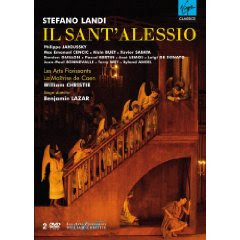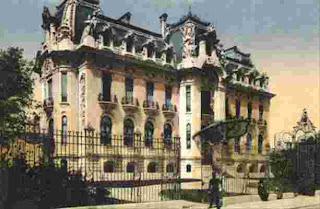

[Apologies for posting irregularity. Maybe something about the moon, tides, and shortness of daylight. And, Happy Birthday
Ludwig!]:
*
"The New Orleans Opera's production of
Pontalba offers a glimmer of good sense to an American classical-music establishment that has not been demonstrating a lot of it. Playing at the Mahalia Jackson Theater, this is a new opera that a city has created about itself. Patrons on Saturday night were also celebrating the 200th anniversary of the Louisiana Purchase, the backdrop for the Pontalba story. Many of them daily walk by Jackson Square, which was designed and built by the French baroness of the title, an American who was born here, lived unhappily and violently in France and returned home in 1849 to oversee this series of elegant facades and galleries. Anyone wondering whether "Pontalba" will find its way to international stages is missing the point. New Orleans offers a particularly vivid example of expansion dreams gone wrong. In the 1980's the New Orleans Symphony thought big, squandering its endowment and hiring marquee conductors with international names, who fled with the first arrival of fiscal pressures, and it failed. Reborn as the self-governing Louisiana Philharmonic, the orchestra played in the pit on Saturday, conducted by the opera company's general director, Robert Lyall.
Thea Musgrave, a Scottish composer with long ties to the American South, was commissioned by the company to write the music and libretto, just as city leaders might have turned to an outside architect to decorate its skyline. But in the final scene, as rotating stage panels formed to enclose the players in a representation of Jackson Square itself, the oohs and ahs of communal identification were palpable.
The problems with "Pontalba" are not musical. It houses three potential operas and can't really decide which one it wants to be. To be fair, it is hostage to sets of historical facts that, although linked, never quite fit the convenient and symmetrical arc on which grand opera thrives. Is this an opera about America's vast acquisition from France and the aftereffects of Spanish rule? Does it center on the baroness de Pontalba and her long life in France among greedy and homicidal in-laws? Or is it about a place in New Orleans, as in the end it decides to be?
Ms. Musgrave composes for the stage with great skill. One can hear her sense of the orchestra and her ear for forward, ever-moving vocal lines as they listen to the events onstage and respond to them moment to moment. The crowd scenes and ensemble work are complex but free of tangles: every crossing musical line has its own clear story to tell. The production, by Jay Lesenger and Erhard Rom, is modest, but its blowups of architectural drawings illustrate a scene's time and place with some precision."
— Bernard Holland - The New York Times 10/7/03
"The story of Micaela Almonester, the 19th century New Orleans businesswoman better known as the Baroness de Pontalba, reads like an opera. Thursday evening at the Mahalia Jackson Theatre of the Performing Arts, it looked and sounded like an opera, too, as the New Orleans Opera Association presented the world premiere of Pontalba, the two-act work on the baroness's life it commissioned from composer Thea Musgrave as part of the celebration of the Louisiana Purchase bicentennial.
The opera also deals with that great land sale and the growth of a nation, which it presents as paralleling the baroness' struggles as she fought to maintain control of her inheritance in a male-dominated society. Two of the most memorable scenes show her father-in-law trying to kill her because she won't bend to his rules and her triumph when she succeeds in constructing her dream buildings, the twin rows of Jackson Square townhouses that still bear her name.
Musgrave wrote the libretto as well as composing the music, resulting in a near-perfect fit between the two."
— Keith Marshall - Times-Picayune 10/4/03
Header images: Baroness Pontalba by Franck Schneider c. 1920s Oil on canvas; and Subpontabla. Both images (c)
Louisiana State Museum. With thanks.
*

Photo credit: (c) Ken Howard 2008. Copyright controlled. Via Opera America Website.



















































